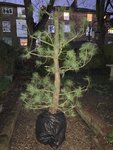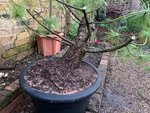Hi guys,
I'm new here, but have seen some great advice given to other queries so thought I'd try my luck...
I've just got my hands on a lovely Scots Pine that's pretty old now with a nice thick trunk at the base (8 inches ish diameter) with a slight curve at the bottom. It's lived it's whole life in a pot so the transplant shouldn't be too difficult for it. I guess I have two questions really.
1. Rather than just cutting the the whole tree back to where I'd like to try and grow a new leader, I was thinking about trying to air layer a new tree out of it half way up first. Do we think this is likely to work and is it worth it, very straight trunk after the bottom foot?
2. Any thoughts on what the long term plan for the main base of the trunk should be? It's got a slight curve and great bark, but is obviously still pretty straight with a very thick trunk. Should I even try and get a leader from the top edge of wherever I cut it down to and attempt to pretend that that was a very tapered trunk all along, or should i just admit that this will always be a separate part of the tree, then maybe pot it at an extreme angle and let a new leader grow straight up from the side half way along (I've seen a few bonsais like this). And perhaps let that main trunk then die back a little as a feature?
Pics attached
Any thoughts would be very much appreciated.
Jay
I'm new here, but have seen some great advice given to other queries so thought I'd try my luck...
I've just got my hands on a lovely Scots Pine that's pretty old now with a nice thick trunk at the base (8 inches ish diameter) with a slight curve at the bottom. It's lived it's whole life in a pot so the transplant shouldn't be too difficult for it. I guess I have two questions really.
1. Rather than just cutting the the whole tree back to where I'd like to try and grow a new leader, I was thinking about trying to air layer a new tree out of it half way up first. Do we think this is likely to work and is it worth it, very straight trunk after the bottom foot?
2. Any thoughts on what the long term plan for the main base of the trunk should be? It's got a slight curve and great bark, but is obviously still pretty straight with a very thick trunk. Should I even try and get a leader from the top edge of wherever I cut it down to and attempt to pretend that that was a very tapered trunk all along, or should i just admit that this will always be a separate part of the tree, then maybe pot it at an extreme angle and let a new leader grow straight up from the side half way along (I've seen a few bonsais like this). And perhaps let that main trunk then die back a little as a feature?
Pics attached
Any thoughts would be very much appreciated.
Jay





